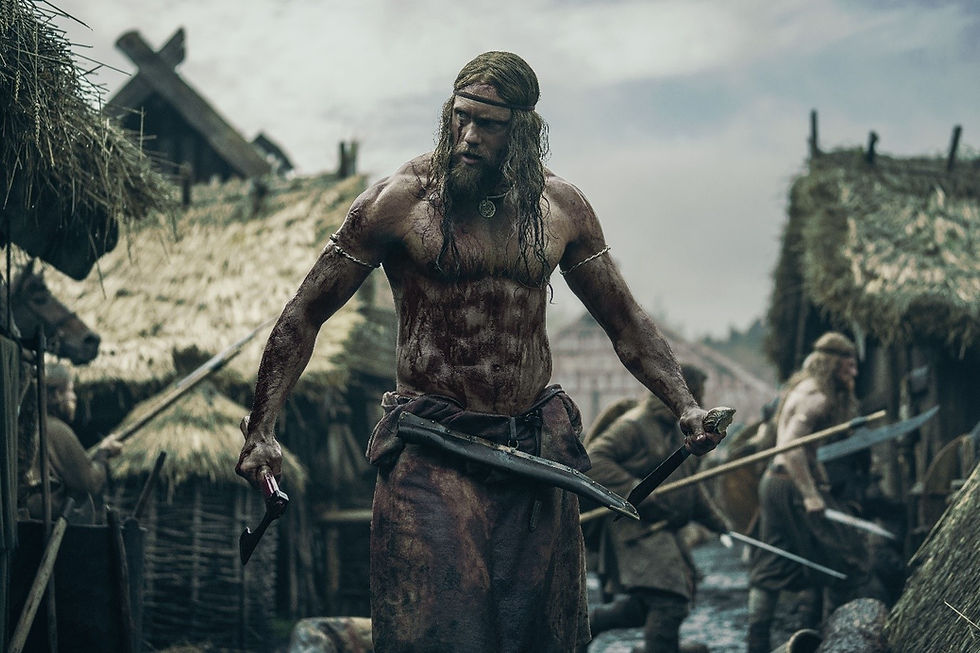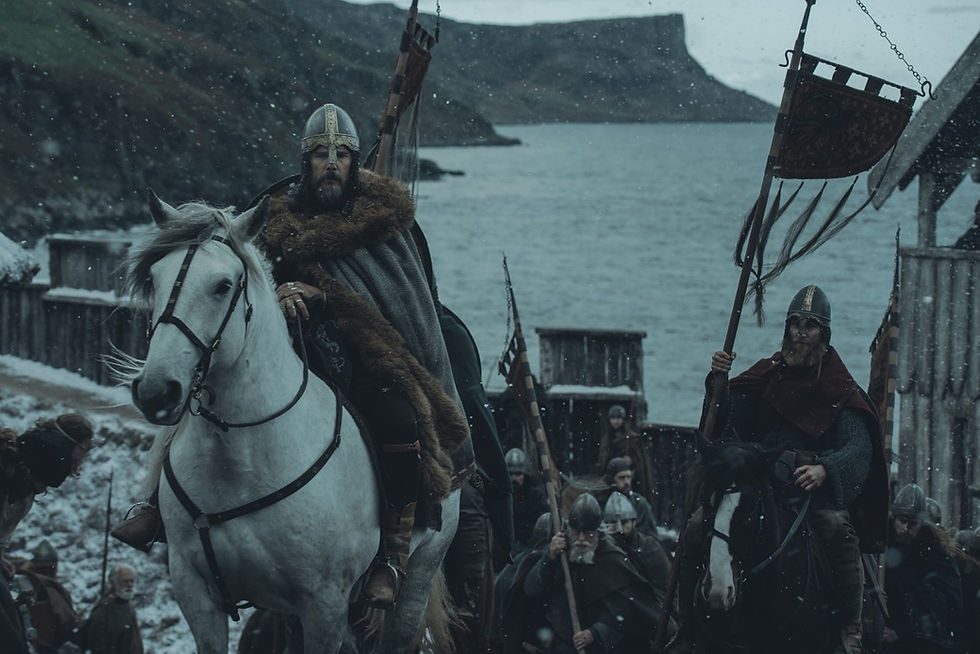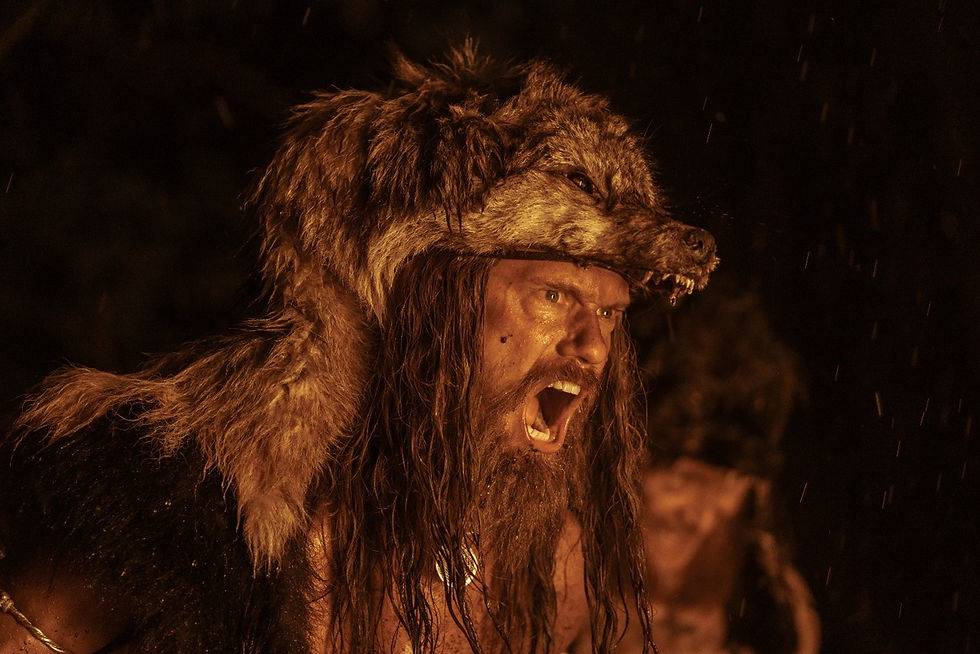Review: The Northman
- EPOCH

- Jun 1, 2022
- 6 min read
Tom Fairfax | University of Nottingham
The medieval era is going through a revival on screen at the moment. 2021 saw two high-profile medieval releases: David Lowery’s The Green Knight, adapting an Arthurian legend, and Ridley Scott’s The Last Duel, drawing on events from fourteenth-century France. Robert Eggers’ The Northman exists somewhere between the fiction of The Green Knight and the realism of The Last Duel. It is based on the story of Amleth from an early thirteenth-century text, Saxo Grammaticus’ Gesta Danorum, which was later the inspiration for Shakespeare’s Hamlet. The Northman brings Amleth’s tale out of Denmark, and turns it into a Viking Age odyssey. The film draws on anecdotes from several texts, taking its audience from a fictional island in the North Atlantic to the rivers of Eastern Europe and, finally, to the volcanic landscape of Iceland.

The backbone of the film is a fictional amalgamation of various texts, stitched together by Eggers and Icelandic co-writer Sjón. This narrative is fleshed out with visuals that reflect archaeological finds and an acute attention to detail. Production designer Craig Lathrop creates fantastic environments for the film, from grand longhouses to humble farmsteads. Even The Northman’s more fanciful surroundings are grounded in real-world examples, the site of a wolf-ritual resembling Maeshowe in Orkney, for example. I think that costume designer Linda Muir deserves credit for some of the best early medieval outfits we’ve seen on screen. An arm ring worn by Ethan Hawke’s King Aurvandill would look at home in the Galloway Hoard, whereas
the film’s helmets resemble the famous Sutton Hoo helmet and Vendel period examples from Scandinavia.
Rather than challenging traditional depictions of the Viking Age head-on, The Northman counters some stereotypes in the background. The keen-eyed viewer will spot that the pendant treasured by Alexander Skarsgård’s Amleth is not Þórr’s hammer or a runic symbol, but an Arabic dirham. These coins, which are found in buried hoards across the viking world, demonstrate the extent of the Scandinavians’ trade network, which connected with the Islamic world in the east. A woman in full armour is briefly shown buying slaves, while another plays a board game at a Rus’ trading site. On more than one occasion, I found myself enjoying the background of the shot more than the foreground, and incidental remarks more than the grand speeches. For example, a raider laughs at King Haraldr of Norway’s conquest of Amleth’s homeland, commenting that Claes Bang’s Fjǫlnir was turned from a king to a ‘sheep farmer’. Those familiar with the sagas’ descriptions of the settlement of Iceland might well chuckle along with him.

I admired the attention paid to the atmospheric backdrop, but I left the cinema unsure of my feelings towards the film, so I decided to re-watch it a few days later. After this, I realised I was struggling with its portrayal of the medieval mindset. The Northman’s characters exist only for violence. The male characters in the film are reduced to howling, bloodthirsty monsters who enjoy the cruelty they inflict. Only Anya Taylor-Joy’s Olga sees a future beyond the bloodshed. Violence was absolutely a part of life in the Viking Age, but people in the Viking Age were still rational people with their own objectives. Medieval texts show us that violence was just one part of the viking toolkit and that when violence was used, it was a means to an end. Raiding was a way to improve wealth and status, whereas punishments maintained control. The Northman presents a society in which violence was an end in itself. Logic gets thrown out of the window. Characters appear to race to their own deaths, each wedded to a religion of violence in which there is no doubt. As Eggers said in an interview in The New Yorker, the society of The Northman is ‘governed by vengeance’. His Viking Age is bleak, primal, and nihilistic.
This is mainly the result of how Eggers and Sjón have arrived at their narrative. Rather than adapting one text, they have combined the most gruesome and violent parts of a range of archaeological and textual sources. For example, the sacrificial murder of a woman and a horse resembles an interpretation of the Oseberg ship burial, and the surrounding ritual calls back to Ibn Fadlan’s account of a Rus’ funeral. Maybe these darker elements lend themselves to the drama required of a blockbuster, but they carry implications of the medieval era with them. The Northman creates the impression that every part of life was violent. However, in the sagas, violent episodes are just one part of someone’s life. Let’s take a post-Viking Age example, Rǫgnvaldr Kali Kǫlsson, whose life is described in the Orkneyinga saga. If we were to narrow down his life to only violent events, we would be left with his wars for the earldom of Orkney, his defeat of a ship on crusade, and his murder in the mid-twelfth century. We might say that he lived a violent life, but this would obscure the fact that he was a poet who enjoyed games, music, and carving runes. The Northman does this for the Viking Age as a whole. While The Northman is constructed from authentic parts, they are removed from their original contexts, and this results in an inauthentic view of the Viking Age mindset. Indeed, there are parts of the film’s narrative that are hard to reconcile with Viking Age literature. In The Northman, grief is seen as a weakness, with Nicole Kidman’s Guðrún telling her husband to ‘be a man’ and to embrace a violent rage. Skarsgård’s Amleth seems never to waver in his desire for Valhǫll. How might these elements be compared with the poem Sonatorrek in Egils saga, in which a tenth-century viking, Egill Skallagrímsson, laments the death of his sons and questions his faith in Óðinn? We cannot expect The Northman to fit the whole experience of the Viking Age into two hours or so, but its characters are almost unthinking and unquestioning. Each believes in their fate absolutely, and this does not seem human at all.

As such, The Northman is the latest perpetrator of a kind of medieval-orientalism, an othering of the past that emphasises the positivity of life in the present. This mirrors the Victorian thinking which cast vikings as savages to emphasise imperialist views of Christian civilisation. Though Eggers is not pushing the same agenda, The Northman’s Viking Age is so dreadful that the film’s audience is reminded of their modern luxuries. It, perhaps unintentionally, encourages us to take some moral high ground over our screaming and bloodthirsty Viking Age forbears. However, violence continues to be a means to an end today, just as it was in the Viking Age. A quick look at the news can tell you that. If we reduced the story of our times to only the violent elements, we might look at ourselves with the same disgust that we look at The Northman’s bloodied vikings. In Eggers’ vengeance-governed world, it seems impossible to live a fulfilling life, but we would think the same of our own age if we defined it by its worst moments.
Ultimately, The Northman confronts how we view the past. Some will hail the film as an authentic portrayal of the viking world, because it draws upon medieval source material. They will see the Viking Age as alien, animalistic, and bleak. For others, The Northman will feel inauthentic because it makes the past feel alien. It is important to remember that despite their nicknames, the people of the Viking Age weren’t wolves, bears, or ravens – they were human beings, capable of all the thoughts and feelings we are capable of now. They were opportunists, looking out for their own interests, trying to enjoy what they had for as long as they had it. Violence was only one part of their life just as it is only one part of ours. Your reaction to The Northman will depend on your view of history. Do you focus on the differences between yourself and the people of the past, or do you focus on the similarities?
Further Reading:
The following books were written by The Northman’s historical advisors:
Jóhanna Katrín Friðriksdóttir, Valkyrie: The Women of the Viking World, (London: Bloomsbury Academic, 2020).
Neil Price, The Children of Ash and Elm: A History of the Vikings' (London: Allen Lane, 2020).
These articles and podcasts comment on the release of The Northman:
Cat Jarman, ‘The Northman: How to Put Vikings On Screen’, Gone Medieval Podcast, 19 April 2022.
Christian Cooijmans, ‘Beyond Hostility and Hypermasculinity: Why We Need to Think Differently About the Vikings’, History Extra, 16 April 2022,
Sam Knight, ‘Robert Eggers’s Historical Visions Go Mainstream’, The New Yorker, March 28 2022.





